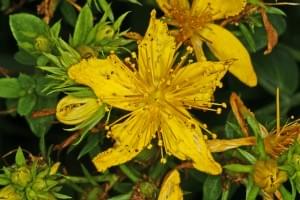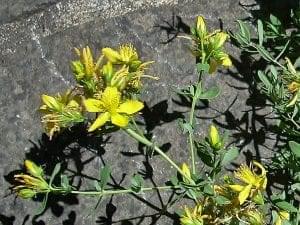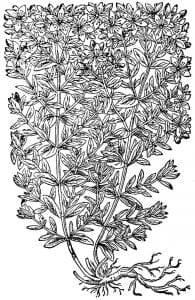
Hypericum perforatum, Hypericaceae family
a.k.a.: Klamath weed, Goat’s weed, Qian Ceng Lou, Fuga Daenomun
Most people think of Saint John’s wort as an antidepressant. It is, but this herb offers so much more. This durable plant helps soothe the nervous system, bolster the immune system, and battles bacteria and viruses to boot.
Saint John’s Wort has been on every herbalist’s list of favorites for centuries. Used either as topical or internal medicine, it heals our ragged nerves like no other, offering deep, spiritual healing that lets us truly drink in the sunny beauty of the world. Saint John’s Wort shines a light strong enough to chase away depression, the blues, and a host of other evils.
Collecting Saint John’s Wort is as pleasurable a medicine for the spirit as is using it. This wayside herb grows vigorously anywhere a little sunlight peaks in. It can be seen blooming merrily away in midsummer in the company of bees and beetles. Saint John’s Wort can lighten a mood for an enlightened herbalist before she’s even harvested it.
Medicinal Properties of St. John’s Wort
Saint John’s wort is primarily used for treating mild to moderate depression. Within the leaves and flowers are potent constituents such as hypericin and hyperforin, which have antidepressant effects. Both these compounds are highly reactive in the body. They each trigger healing effects to the nervous system.
Hyperflorin increases concentrations of sodium (Na+) and calcium (Ca2+) in the blood stream. This helps Saint John’s Wort fight depression. These minerals are essential to smooth, effective connections between neurons and strong bonds between those same neurons and their neurotransmitters, including serotonin. Chemical antidepressants block serotonin from making the jump across the synaptic cleft between the neurons. In contrast, hyperforin helps serotonin to better connect with the synapse receptors by allowing it to remain in the synaptic cleft longer so it can bind to the synaptic receptor better by forming a tighter bond. A loose bond causes a lesser response from the synapse and therefore make the serotonin less effective.
In addition, hyperflorin causes mononamine neurotransmitters, which help process emotion, to remain in the synaptic cleft longer and therefore form tighter bonds by creating an environment that’s favorable for those stronger bonds. This is unlike conventional drugs in that prescription antidepressants seek to increase mononamine neurotransmitters by preventing the receptors from letting go rather than by creating a receptor that wants to hang on. Saint John’s wort’s constituents essentially create an environment that’s tenacious about making the most of all the seritonin and mononamine the body can.
Saint John’s wort is rich in flavonoids and biflavonoids. This list contains some “all star players.” Among them are quercitin, rutin, luteolin, kaempferol, hyperoside, and myricetin. These are some of the flavonoids that effect neurotransmitters by inhibiting monoamine oxidase (MAO). Simply put, MAO is the enzyme found between nerve cells that degrades neurotransmitters. MAO enzymes are thought to share responsibility for triggering a wide range of conditions such as anxiety, depression, and PTSD as well as neurological disorders as severe as Parkinson’s disease.
Hypericin works synergistically with 5-HT in the body to keep serotonin and norepinephrine levels levels healthy. It’s also antiviral and antibiotic. Many studies have been published proving its effect against even stubborn diseases such as MRSA and herpes.
Additionally, hypericin non competitively inhibits synaptic re uptake of serotonin, dopamine, nora adrenaline, monoamines, and amino acid neurotransmitters such as GABA and glutamate. Neurotransmitters are the chemicals from the brain that communicate with the rest of the body. Simply put, hypericin initiates the body’s natural ability to relax.
Hypericin (and hypericin-like compounds such as pseudohypericin, isohypericin and protohypericine) make up between 0.50-0.3 percent of Saint John’s wort’s chemistry. These compounds are the focus of studies on Saint John’s wort broad spectrum antiviral effects. The last few decades have produced a number of results pointing to this herb’s defense against viruses as varied as HIV-1, influenza, herpes, and human poliovirus 1. In studies that bring hypericin to bat against retroviruses, our favorite herb is winning the game.
All of this complicated chemistry has other properties as well. Saint John’s wort is noted as an effective antibiotic. It works to protect against both Gram negative bacteria (such as Staphylococcus auerus) and Gram positive bacteria (such as E. coli). It’s interesting to note that Saint John’s wort doesn’t have an effect on L. Acidophilus, which may explain why it’s safe to use for people who are prone to yeast infections triggered by standard antibiotics.
Studies show Saint John’s wort also works against fungal infections as well as serving as a natural anti-inflammatory herb. The combination of the compounds with the flavonoids is supportive of many of the body’s natural healing capabilities.
Essential oil of Saint John’s wort is generally rare and expensive. It takes a whole lot of flowers to produce very little essential oil, thus the high price tag. Since the essential oil doesn’t contain hypericin or hypericin’s cousins, Saint John’s wort essential oil isn’t especially useful for anxiety and depression. Not much study is dedicated to the essential oil, so we have far less data on how the essential oils in Saint John’s wort contribute to the whole plant’s healing properties. The primary constituents of this essential oil are: Sesquiterpenes, caryophyllene, germacrene, alkanes, alcohols, oxides, and 2 percent ketones. Saint John’s wort essential oil is antispasmodic and anti-inflammatory and is considered a middle to base note when blending.
Conditions Best Helped by St. John’s Wort
Depression is a common ailment. Between three and five percent of the world’s population struggles with depression to the point where they need treatment in order to carry on with their lives. For mild to moderate depression, Saint John’s wort is very helpful. It’s particularly good for depression caused by an incident or abuse. It works to heal the broken pathways and support healing of the damage caused by trauma. Saint John’s wort is a good herb to use in conjunction with other techniques such as therapy and nutritional support.
As a homeopathic or flower essence, Saint John’s wort can help those who are particularly sensitive protect themselves and heal depressed conditions. With its strong solar energies, Saint John’s wort is perfectly designed to help us honor our inner light and find light in dark conditions. People who suffer from Seasonal Affective Disorder (SAD), depression, and find themselves particularly sensitive to the moods of those around them, particularly the darker or heavier moods, can try coupled Saint John’s wort flower essence with Yarrow flower essence. Together, these flower essences help the spirit release that which isn’t appropriate, create an appropriate and healthful layer of energetic protection for the soul, and recognize and strengthen the inner light.
Sensitive children who are prone to nightmares and/or bed wetting benefit from a nightly dose of Saint John’s wort flower essence or homeopathic remedy. Often, children who are prone to these problems expand further beyond their bodies during slumber than their peers. Saint John’s wort flower essence or homeopathic remedies can help them create a more appropriate boundary, helping them feel safe and empowered during nightmares or night terrors, and letting them learn to recognize their body’s needs even from deep slumber.
One of the often sited side effects of Saint John’s wort is increased photo-sensitivity. For people who sunburn easily this is a deep concern in the summer. For people with Seasonal Affective Disorder (SAD), this is an advantage. Saint John’s wort can help their skin absorb more of the sun’s energy and nutrients, keeping the worst of the blues at bay. Homeopathic doses of Saint John’s wort as Hypericum or Hypericum per. or in homeopathic tincture form can help individuals to decrease sun sensitivity. This is particularly useful for individuals who are fair-skinned or strongly sensitive in general.
Saint John’s wort is a common ingredient in blends for depression or pain. As it treats the nervous system, it’s a great herb to use in conjunction with other nervines such as oats. Combinations like these can be used in smaller doses to relieve stress. Some herbalists like to combine it with sedatives and pain relievers like skullcap, passionflower, or California poppy. It’s best used long term to effectively treat depression.
As Saint John’s wort is both a nervine and a sedative, it works well for people with anxiety and sleep disorders. Sleeplessness can be trigger by many issues: Nerve pain, anxiety, fear, depression, or digestive distress. People who experience night terrors (a more severe form of nightmares) have found relief with regular dosage of Saint John’s wort tincture. Homeopathic remedies or flower essence of Saint John’s wort are particularly indicated for such individuals as well. Saint John’s wort flower essence and homeopathic remedies have been used successfully to combat insomnia, night sweats, nightmares, and night time incontinence as well.
Many people reach for Saint John’s wort oil first when they pull a muscle. There’s a good reason why it’s used as a base for natural muscle salves. It decreases inflammation and nerve irritation. For muscle sprains and strains, Saint John’s wort helps the tissues release heat and swelling so they can heal. Muscles injured by crushing or smashing, such as finger smashed in a car door, are particularly helped by a topical dose of this herb with or without a supporting internal dose. This oil is also excellent for treating neuropathic conditions characterized by sharp pain, numbness, burning sensations, and constant tingling in the damaged areas.
Saint John’s wort liniment is a good treatment for scrapes, bruises, and minor burns. This is one herb that helps heal broken capillaries. Liniments use a witch hazel extract or vinegar base (some commercial liniments have rubbing alcohol bases) rather than an oil, making them particularly appropriate for conditions that need cooling or areas and skin that won’t tolerate excess oil. Saint John’s wort liniment can be dabbed on minor wounds with a cotton ball or sprayed over the wound using a spritzer bottle. Saint John’s wort liniments are soothing for minor sunburn with a follow up of aloe vera. Try adding calendula and lavender to your Saint John’s wort liniment blend for sunburns as well. Together, they’ll ease the burning sensation.
Bacterial infections do not stand much of a chance against Saint John’s wort. Even stubborn staph infections back off when this herb is applied. The tincture can be applied directly to an unopened wound with a cotton ball. Take Saint John’s wort combined with Oregon grape internally to contain and treat staph. As with all antibiotics, continue to use the treatment for several days after the physical signs of infection have gone to be sure the bacteria is out of your system.
Add Saint John’s wort to formulas for varicose veins and hemorrhoids. It combines well with other astringents such as yarrow and stone root. Saint John’s wort can be applied topically as a liniment or a salve, and it can be taken internally as a tincture to support the whole system.
Arthritis is an inflammatory condition gently helped by Saint John’s wort that becomes more common as we age. Gout is another condition sometimes associated with age that can use the soothing properties of Saint John’s wort. Although these conditions stem from different causes, they can be treated with one formula when Saint John’s wort is part of that mix. Devil’s claw and juniper work with Saint John’s wort in blends to treat both arthritis and gout quite effectively.
Many people are unaware of Saint John’s wort’s capacity to heal infections in the herpes family. This virus family includes but is not limited to shingles, chicken pox, oral herpes, genital herpes, and mononucleosis. The redness, irritation, and inflammation from this virus can be excruciating. For people with reoccurring shingles or herpes, Saint John’s wort and Melissa Officinalis, or Lemon Balm, can be used as a preventative when the first signs occur. Tincture is best. Also, remember to monitor your diet for B vitamins, trace minerals, and amino acids to fortify your system.
Saint John’s wort essential oil is antispasmodic and anti-inflammatory, making it a good choice for loosening tension. This essential oil has an affinity for easing tension headaches, including menopausal and adolescent headaches. Use it topically diluted in a carrier oil or try a few drops in your aromatherapy burner. Essential oils such as lavender, rose geranium, and rosemary that help relax muscles and ease tension would be good choices for use with Saint John’s wort essential oil to treat tension.
For More Information on St. John’s Wort
For more information on Saint John’s Wort, purchase a copy of The Practical Herbalist’s Herbal Folio: Saint John’s Wort: Antidepressant & So Much More. This Herbal Folio contains expanded information, including:
- Gardening and Gathering
- Animal Husbandry
- Household Formulas
- History, Folklore, Myth, and Magic
- Cautions
- Recipes
- Quick Facts
- References
Proceeds from sales of The Practical Herbalist’s Herbal Folio series go toward supporting The Practical Herbalist website. Support this terrific reference site by buying your copy of Saint John’s Wort: Antidepressant & So Much More today.








